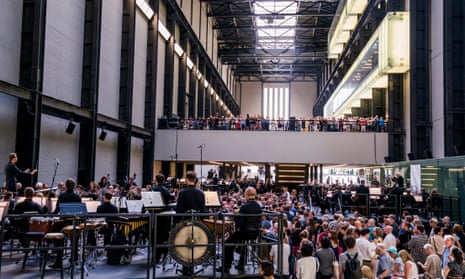Karlheinz Stockhausen was no stranger to writing music that turned a performance into an event – this, after all, is the man who wrote music for a string quartet playing from within four helicopters. The importance of making concerts into events is something that Simon Rattle has brought back to the London Symphony Orchestra in his first season as music director.
Stockhausen’s 1958 masterwork Gruppen für drei Orchester (Groups for three orchestras) involves no helicopters, but the forces it does require – three spatially separated orchestras comprising about 100 musicians all told, and three conductors – plus its sheer intricacy, are enough to make it a rare work to experience live. But this is as much an art installation as a concert work, and in many ways it was right at home in Tate Modern’s Turbine Hall.

Saturday’s two performances had a paying audience standing on the hall’s floor, but could be seen and heard by other gallery visitors from the windows and balconies all around.
The work Rattle had chosen to precede Gruppen was equally at home here. Messiaen’s Et exspecto resurrectionem mortuorum, commemorating the dead of the second world war, is a monolithic piece, scored for a barrage of wind, brass and percussion.
The public nature of the space felt entirely appropriate and the music made a forceful impact, but there were moments of quiet, intense beauty too. The final movement, with the gong pulsing, suggested a giant creature slowly breathing; then the sound grew into a mass of noise that seemed to feed off itself. It was exhilarating to the ear.
Gruppen is a different beast. For all its massed musicians, it is a thing of tiny, pin-drop details. The three stages were set up at the points of a triangle, so the conductors – Rattle, Matthias Pintscher and Duncan Ward – could have eye contact.
Rattle encouraged us to move around, quietly, to gain different perspectives and so one found oneself perhaps next to the trombones as they offered gruff punctuation, or to the side drum as it tried to whip up the argument.
The passages that worked best, though, were the moments of true surround sound, where the three orchestras came together to send single notes or chords scything around the space.
Again, it was impossible to hear every detail – but if you wanted that you could have stayed at home with a recording. This was something different: a live performance, music as an event.


Comments (…)
Sign in or create your Guardian account to join the discussion